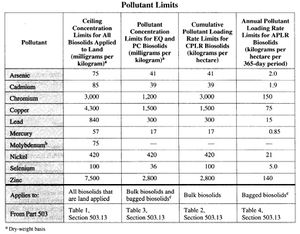Class B Biosolids
|
WARNING! Sewage sludge is toxic. Food should not be grown in "biosolids." Join the Food Rights Network. |
Class B Biosolids is a designation for treated sewage sludge that meets U.S. EPA guidelines for land application as fertilizer with restrictions that are noted below. Compared to Class A Biosolids, Class B Biosolids are allowed to have detectable pathogens. All other regulations for contaminants in the two classes are the same. Despite the U.S. EPA's assurances of safety,[1], the safety requirements for Class B Biosolids are insufficient to ensure safety. Animals fed forage crops grown in soil fertilized with Class B Biosolids have died and humans working in the fields where Class B Biosolids were applied have been sickened.[2]
Contents
U.S. EPA Standards for Metal Contaminants in Class B Biosolids
The U.S. EPA sets limits for concentrations of ten metals in sewage sludge classified as Class B Biosolids.[3] All concentrations listed are dry-weight concentrations:
- Arsenic: 75 parts per million (ppm)
- Cadmium: 85 ppm
- Chromium: 3000 ppm
- Copper: 4,300 ppm
- Lead: 840 ppm
- Mercury: 57 ppm
- Molybdenum: 75 ppm
- Nickel: 420 ppm
- Selenium: 100 ppm
- Zinc: 7,500 ppm
Restrictions on Use of Class B Biosolids
Class B biosolids may not be applied to home lawns and gardens. Additionally, the following restrictions apply:[4]
- "Restrictions for the harvesting of crops and turf:
- 1. Food crops, feed crops, and fiber crops, whose edible parts do not touch the surface of the soil, shall not be harvested until 30 days after biosolids application.
- 2. Food crops with harvested parts that touch the biosolid/soil mixture and are totally above ground shall not be harvested until 14 months after application of biosolids.
- 3. Food crops with harvested parts below the land surface where biosolids remain on the land surface for 4 months or longer prior to incorporation into the soil shall not be harvested until 20 months after biosolids application.
- 4. Food crops with harvested parts below the land surface where biosolids remain on the land surface for less than 4 months prior to incorporation shall not be harvested until 38 months after biosolids application.
- 5. Turf grown on land where biosolids are applied shall not be harvested until 1 year after application of the biosolids when the harvested turf is placed on either land with a high potential for public exposure or a lawn, unless otherwise specified by the permitting authority.
- "Restriction for the grazing of animals:
- 1. Animals shall not be grazed on land until 30 days after application of biosolids to the land.
- "Restrictions for public contact:
- 1. Access to land with a high potential for public exposure, such as a park or ballfield, is restricted for 1 year after biosolids application. Examples of restricted access include posting with no trespassing signs, and fencing.
- 2. Access to land with a low potential for public exposure (e.g., private farmland) is restricted for 30 days after biosolids application. An example of restricted access is remoteness."
Related SourceWatch articles
References
- ↑ http://www.epa.gov/owmitnet/mtb/biosolids/genqa.htm
- ↑ Andy McElmurray, Testimony Before U.S. Congress, Accessed August 3, 2010
- ↑ Code of Federal Regulations, Title 40, Chapter 1, Subchapter O, PART 503—Standards for the Use or Disposal of Sewage Sludge, Subpart B—Land Application, Pollutant Limits
- ↑ EPA's Guide to Part 503 Rule, Chapter 2, Land Application of Biosolids, p. 38.
External resources
External articles
| This article is a stub. You can help by expanding it. |

